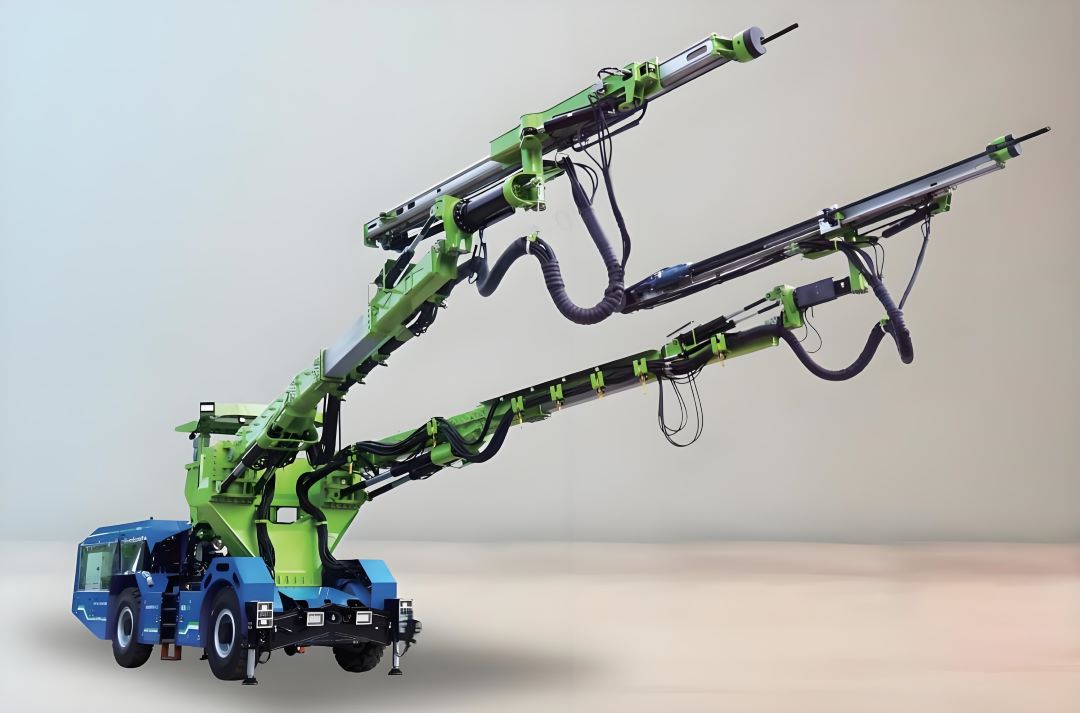What is a jumbo drill machine? A "jumbo drill machine" (often referred to as a "drill jumbo") is a type of heavy machinery used in underground mining, tunneling, and civil engineering projects. It is primarily used for drilling holes into rock for the purpose of blasting, anchoring, or creating tunnels. The machine is designed to handle large-scale drilling tasks in difficult, hard-to-reach underground environments.
- 
Type of jumbo drill machine
1. Single Boom Jumbo Drill
- Description: This type of machine has one large, hydraulic boom with a single drill unit. It is typically used for smaller tunneling projects or where access space is limited.
- Use Cases: Often used in narrow tunnels or for drilling exploratory holes.
- Advantages: Compact size, excellent maneuverability in confined spaces.
2. Double Boom Jumbo Drill
- Description: A double boom jumbo drill has two hydraulic booms, each with its own drill unit. This allows for drilling multiple holes simultaneously, improving efficiency.
- Use Cases: Commonly used in larger tunneling projects, such as road tunnels, mine shaft construction, and metro stations.
- Advantages: Increased productivity as it can drill in two or more locations at the same time.
3. Triple Boom Jumbo Drill
- Features three booms, further increasing drilling capacity and efficiency for large-scale tunneling operations.
4. Crawler-Mounted Jumbo Drill
- Description: This type of jumbo drill is mounted on crawler tracks, providing excellent mobility in rough and uneven terrain. It's ideal for working in underground conditions where the surface may be unstable.
- Use Cases: Mainly used in mining and tunnel construction, especially in hard rock conditions.
- Advantages: High mobility and stability, can handle rough or steep terrain.
5. Wheeled Jumbo Drill
- Description: These drills are mounted on wheels rather than tracks. They are often used in environments where mobility over longer distances is needed, such as in larger tunnel projects or when moving between different sections of a mine.
- Use Cases: Suitable for flatter terrain or longer stretches of tunnels.
- Advantages: Faster mobility over smooth surfaces, suitable for larger construction sites.
6. Rod-Buster Jumbo Drill
- Description: A rod-buster drill is designed for drilling holes specifically for rock bolts, which are used to support the tunnel walls. It has the specialized capability of installing these bolts into the rock to stabilize the structure.
- Use Cases: Mining operations, tunnel stabilization, and underground construction projects.
- Advantages: Specific functionality for rock reinforcement, ensuring tunnel safety.
7. Long-Reach Jumbo Drill
- Description: These drills have extended booms or telescoping arms that allow for a longer reach. They are ideal for deep tunnel sections or situations where the drill must reach high up on tunnel walls or ceilings.
- Use Cases: High tunnels, deep shafts, or large underground construction projects.
- Advantages: Greater versatility and ability to reach difficult areas.
8. Battery-Electric Jumbo Drill
- Description: With growing emphasis on environmental concerns and reducing emissions in underground operations, battery-electric jumbo drills have become more popular. They are powered by batteries instead of traditional diesel engines, offering cleaner operation in confined underground spaces.
- Use Cases: Mines or tunnels with strict environmental or air quality regulations.
- Advantages: Zero emissions, reduced noise, and improved air quality in underground environments.
9. Continuous Mining Jumbo Drill
- Description: Some jumbo drills are designed to operate continuously in mining operations. These drills often have the ability to switch between drilling, loading, and transporting materials in a continuous cycle, making them highly efficient.
- Use Cases: Mining operations with high throughput needs, especially in ore extraction.
- Advantages: Continuous operation without interruptions, high productivity.
10. Face drilling jumbo Drill
- Description: This type of drill is used for face drilling, where it drills holes into the tunnel face to prepare for blasting. It can be used for both vertical and horizontal drilling.
- Use Cases: Primarily used in tunnel construction and mining to break rock or prepare for blasting.
- Advantages: High precision for controlled blasting, important for tunnel expansion and mining.
These machines are integral in projects that require large-scale tunneling, such as in mining (for ore extraction), subway construction, and other infrastructure projects. They can drill multiple holes at once, often in different directions, to create blast patterns or set up reinforcement supports in tunnels.





